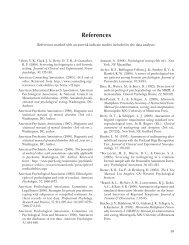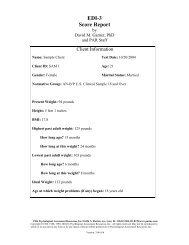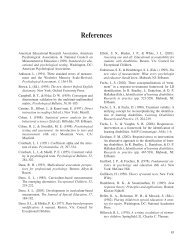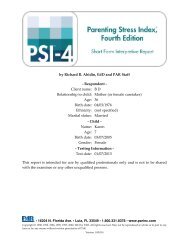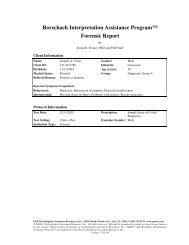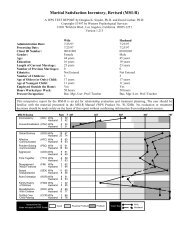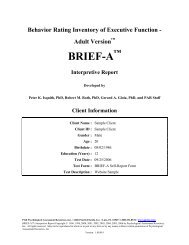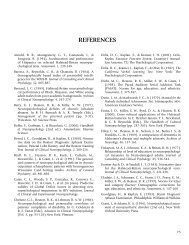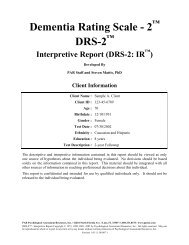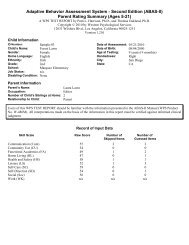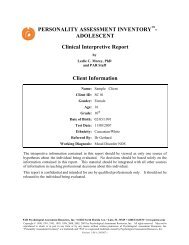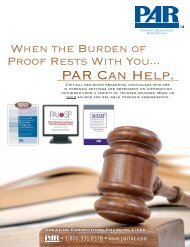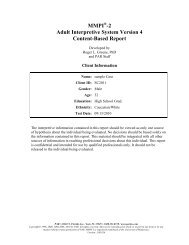MMPI-A Interpretive Report - Psychological Assessment Resources ...
MMPI-A Interpretive Report - Psychological Assessment Resources ...
MMPI-A Interpretive Report - Psychological Assessment Resources ...
Create successful ePaper yourself
Turn your PDF publications into a flip-book with our unique Google optimized e-Paper software.
y Robert P. Archer, PhD and PAR StaffClient InformationName: John SampleClient ID: 1234Gender: MaleDate of birth: 04/03/1997Age: 16Grade level: 10Setting: OutpatientTest date: 05/15/2013This report is intended for use by qualified professionals only and is not to be sharedwith the examinee or any other unqualified persons.• 16204 N. Florida Ave. • Lutz, FL 33549 • 1.800.331.8378 • www.parinc.comCopyright © 1992, 1995, 2000, 2002, 2003, 2005, 2008, 2013 by PAR. All rights reserved. May not be reproduced in whole or in partin any form or by any means without written permission of PAR. <strong>MMPI</strong> is a registered trademark of the University of Minnesota.Version: 5.00.039
Profile Matches and ScoresClient profileHighest scale Best-fitcodetype codetypeCodetype match: 4-9/9-4 4-9/9-4Coefficient of fit: 0.940 0.940ScoresF (Infrequency) 53 53 53L (Lie) 46 48 48K (Correction) 44 47 47Hs (Scale 1) 55 49 49D (Scale 2) 51 50 50Hy (Scale 3) 58 49 49Pd (Scale 4) 83 70 70Mf (Scale 5) 49 44 44Pa (Scale 6) 63 54 54Pt (Scale 7) 60 52 52Sc (Scale 8) 56 55 55Ma (Scale 9) 81 72 72Si (Scale 0) 38 45 45Codetype definition in T-score points 18 15 15Mean clinical scale elevation 63.0 56.3 56.3Mean excitatory scale elevation 73.0 65.4 65.4Mean age - Females 15.4 15.4Mean age - Males 15.5 15.5Percent of cases 6.5 6.5Configural clinical scale interpretation is provided in the report for the following codetype(s):4-9/9-4Unanswered (?) Items 1Welsh code49"'+67-3812/5:0# F/LK:<strong>MMPI</strong>-A <strong>Interpretive</strong> <strong>Report</strong> Page 2John Sample (1234) Test date: 05/15/2013
Validity and Clinical ScalesT score 120T score 1201101101001009090Pd (4)Ma (9)80807070F1Pa (6)60Pt (7)60FHs (1)Hy (3)Sc (8)50TRIND (2)Mf (5)5040F2LK40VRINSi (0) 30Scale VRIN TRIN F1 F2 F L K Hs (1) D (2) Hy (3) Pd (4) Mf (5) Pa (6) Pt (7) Sc (8) Ma (9) Si (0)T score 39 50 65 44 53 46 44 55 51 58 83 49 63 60 56 81 38 30Client Profile<strong>MMPI</strong>-A <strong>Interpretive</strong> <strong>Report</strong> Page 3John Sample (1234) Test date: 05/15/2013
Content and Supplementary ScalesT score 120T score 120110110100100909080PRO80A-angA-con70A-anxA-cynA-lasA-schMACRIMM70A-aln6060A-fam50A-obsA-depA-heaA-bizACKA50A-trt40A-sodR40A-lse 30Scale A-anxA-obsA-depA-heaA-aln A-biz A-angA-cynA-con A-lse A-las A-sodA-famA-sch A-trtMACRACK PRO IMM A RT score 69 51 49 49 62 53 74 69 75 34 69 39 54 65 46 70 50 78 67 52 40 30Client Profile<strong>MMPI</strong>-A <strong>Interpretive</strong> <strong>Report</strong> Page 4John Sample (1234) Test date: 05/15/2013
PSY-5 ScalesT score 120T score 1201101101001009090DISC808070AGGR70PSYC60NEGE60505040INTR40 30Scale AGGR PSYC DISC NEGE INTRT score 70 67 83 60 41 30Client Profile<strong>MMPI</strong>-A <strong>Interpretive</strong> <strong>Report</strong> Page 5John Sample (1234) Test date: 05/15/2013
Harris-Lingoes and Si SubscalesScale aT scoreDepression subscaleSubjective Depression (D1) 51Psychomotor Retardation (D2) 41Physical Malfunctioning (D3) 55Mental Dullness (D4) 56Brooding (D5) 41Hysteria subscaleDenial of Social Anxiety (Hy1) 61Need for Affection (Hy2) 46Lassitude-Malaise (Hy3) 62Somatic Complaints (Hy4) 53Inhibition of Aggression (Hy5) 44Psychopathic Deviate subscaleFamilial Discord (Pd1) 59Authority Problems (Pd2)Social Imperturbability (Pd3)Social Alienation (Pd4)Self-Alienation (Pd5)Paranoia subscalesPersecutory Ideas (Pa1)73 a67 a74 a65 a78 aPoignancy (Pa2) 42Naiveté (Pa3) 40Schizophrenia subscaleSocial Alienation (Sc1) 62Emotional Alienation (Sc2) 48Lack of Ego Mastery, Cognitive (Sc3) 55Lack of Ego Mastery, Conative (Sc4) 57Lack of Ego Mastery, Defective Inhibition (Sc5) 57Bizarre Sensory Experiences (Sc6) 47Hypomania subscaleAmorality (Ma1)Psychomotor Acceleration (Ma2)73 a71 aImperturbability (Ma3) 55Ego Inflation (Ma4) 64Social Introversion subscaleShyness/Self-Consciousness (Si1) 36<strong>MMPI</strong>-A <strong>Interpretive</strong> <strong>Report</strong> Page 6John Sample (1234) Test date: 05/15/2013
Social Avoidance (Si2) 38Alienation-Self and Others (Si3) 54aT scores for subscales printed in bold are T ≥ 65 and the corresponding Main Clinical scale is T ≥ 60.<strong>MMPI</strong>-A <strong>Interpretive</strong> <strong>Report</strong> Page 7John Sample (1234) Test date: 05/15/2013
Content Component ScalesScale aT scoreDepressionDysphoria (A-dep1) 47Self-Depreciation (A-dep2) 52Lack of Drive (A-dep3) 47Suicidal Ideation (A-dep4) 42Health ConcernsGastrointestinal Symptoms (A-hea1) 46Neurological Symptoms (A-hea2) 46General Health Concerns (A-hea3) 45AlienationMisunderstood (A-aln1) 64Social Isolation (A-aln2) 38Interpersonal Skepticism (A-aln3)73 aBizarre MentationPsychotic Symptomatology (A-biz1) 48Paranoid Ideation (A-biz2) 75AngerExplosive Behavior (A-ang1)66 aIrritability (A-ang2)70 aCynicismMisanthropic Beliefs (A-cyn1) 58Interpersonal Suspiciousness (A-cyn2)Conduct ProblemsActing-Out Behaviors (A-con1)Antisocial Attitudes (A-con2)69 a70 a68 aNegative Peer Group Influences (A-con3) 51Low Self-EsteemSelf-Doubt (A-lse1) 36Interpersonal Submissiveness (A-lse2) 38Low AspirationsLow Achievement Orientation (A-las1)69 aLack of Initiative (A-las2) 49Social DiscomfortIntroversion (A-sod1) 36Shyness (A-sod2) 44<strong>MMPI</strong>-A <strong>Interpretive</strong> <strong>Report</strong> Page 8John Sample (1234) Test date: 05/15/2013
aT scores for subscales printed in bold are T ≥ 65 and the corresponding Main Content scale is T ≥ 60.<strong>MMPI</strong>-A <strong>Interpretive</strong> <strong>Report</strong> Page 9John Sample (1234) Test date: 05/15/2013
Content Component Scales (continued)Scale aT scoreFamily ProblemsFamilial Discord (A-fam1) 63Familial Alienation (A-fam2) 49School ProblemsSchool Conduct Problems (A-sch1)69 aNegative Attitudes (A-sch2)74 aNegative Treatment IndicatorsLow Motivation (A-trt1) 45Inability to Disclose (A-trt2) 53aT scores for subscales printed in bold are T ≥ 65 and the corresponding Main Content scale is T ≥ 60.Specified SettingThis adolescent was assessed in an outpatient setting.Configural Validity Scale InterpretationThis adolescent has produced a consistent <strong>MMPI</strong>-A response pattern, reflected inacceptable values on validity scales VRIN and TRIN.This F-L-K validity scale configuration is indicative of an adolescent who responded tothe <strong>MMPI</strong>-A in a valid, accurate, and cooperative manner. The validity scale featuresproduced by this teenager are characteristic of normal adolescents and are unusual forteenagers evaluated in psychiatric settings.Both F1 and F2 T scores are below 90. T-score values of 90 or greater on either F1 or F2are likely to indicate problems with profile validity.Validity ScalesRaw (?) = 1There were a few item responses omitted in completing this <strong>MMPI</strong>-A.These omissions may represent areas of limitation in the adolescent's lifeexperience that rendered certain items unanswerable or limitations in theadolescent's reading ability. There is little probability of profile distortionas a result of these few item omissions.<strong>MMPI</strong>-A <strong>Interpretive</strong> <strong>Report</strong> Page 10John Sample (1234) Test date: 05/15/2013
Variable Response Inconsistency (VRIN) = 39VRIN scores in this range suggest that the adolescent responded to testitems with an acceptable level of consistency.True Response Inconsistency (TRIN) = 50TRIN scores in this range suggest that the adolescent responded to testitems with an acceptable level of consistency.Infrequency 1 (F1) = 65Scores in this range reflect a marginal or moderate elevation in unusualpsychiatric symptomatology as presented in the first part of the <strong>MMPI</strong>-Atest booklet.Infrequency 2 (F2) = 44Scores in this range may be produced by normally adjusted adolescentswho have had very conventional life histories or by adolescents withpsychological problems who are consciously or unconsciously attemptingto deny serious psychopathology as presented in the latter part of the<strong>MMPI</strong>-A test booklet.Infrequency (F) = 53Scores in this range usually indicate that the respondent has answered thetest items in a manner similar to most normal adolescents. Although someclinical scale scores may be elevated, this teenager has not reported manysymptoms of highly deviant/unusual psychopathology.Lie (L) = 46Scores in this range suggest an appropriate balance between theadmission and the denial of common social faults. These adolescents areoften viewed as flexible and psychologically sophisticated.Correction (K) = 44The majority of adolescents obtain scores in this range, which represent anappropriate balance between self-disclosure and guardedness. Prognosisfor psychotherapy is often good because such adolescents are open todiscussion of life problems and symptoms.<strong>MMPI</strong>-A <strong>Interpretive</strong> <strong>Report</strong> Page 11John Sample (1234) Test date: 05/15/2013
4-9/9-4 CodetypeConfigural Clinical Scale InterpretationThis <strong>MMPI</strong>-A profile is classified as a 4-9/9-4 codetype. It occurs morefrequently among adolescents than adults and is found in 7% to more than10% of adolescents, depending on the clinical setting.Teenagers who obtain this profile type display a marked disregard forsocial standards and are likely to manifest problems related to acting-outand impulsivity. They are described as egocentric, narcissistic, selfish, andself-indulgent, and are often unwilling to accept responsibility for theirbehaviors. In social situations, these teenagers are extroverted and appearto make an excellent first impression. Their egocentric interpersonal style,however, typically results in chronic difficulties in establishing close andenduring relationships. They are usually referred for treatment because ofdefiance, disobedience, impulsivity, provocative behavior, and truancy inschool. Additionally, the IMM score indicates this adolescent might bedescribed as immature, easily frustrated, impatient, defiant, egocentric,and concrete. Many teenagers with this codetype will develop a history ofrepeated legal violations and court actions. Findings from the A-concontent scale indicate that this adolescent has reported attitudes andbehaviors related to conduct disorder symptomatology. Drug or alcoholuse is also common among adolescents with this codetype. Findings fromsupplementary scales related to substance abuse (MAC-R, ACK, or PRO)also indicate that this adolescent has an increased probability of alcohol ordrug abuse problems.Adolescents who produce this codetype frequently receive Cluster BPersonality Disorder diagnoses (301.XX) and/or Conduct Disorderdiagnoses (312.8). Their primary defense mechanism consists ofacting-out, and these teenagers often enter treatment settings withoutevidence of substantial emotional distress such as anxiety or depression.Therapists perceive these adolescents as resentful of authority figures,narcissistic, egocentric, socially extroverted, self-centered, selfish, anddemanding. Adults with this codetype have a markedly poor prognosisfor personality or behavior change as a result of psychotherapy. Theprognosis for adolescents with this codetype probably is inversely relatedto the age at which psychotherapy is undertaken: The earlier thepsychological intervention, the greater the probability of successfultreatment. Treatment efforts might focus on the relationships between theadolescent's behavior and its environmental consequences; that is, holdingthe adolescent consistently responsible for his behavior and setting<strong>MMPI</strong>-A <strong>Interpretive</strong> <strong>Report</strong> Page 12John Sample (1234) Test date: 05/15/2013
Scale 1 (Hs) = 55appropriate limits and consequences for irresponsible or antisocialbehaviors. In this latter regard, the use of carefully structured legalrestrictions, such as clearly defined probation contingencies, are oftenuseful for teenagers who have manifested repeated legal violations.Clinical ScalesThe obtained score is within normal or expected ranges. This adolescenthas not expressed a pattern of unusual concerns or preoccupationsregarding physical health or functioning.Scale 2 (D) = 51The obtained score is within normal or expected ranges, and depressivesymptomatology was not reported as a problem area for this adolescent.Scale 3 (Hy) = 58The obtained score is within normal or expected ranges, and thisadolescent probably has the capacity to acknowledge unpleasant issues ornegative feelings.Scale 4 (Pd) = 83Scale 4 high points are very common among adolescents, particularlyamong those in psychiatric or criminal justice settings. Scores in this rangeare typical for adolescents who are characterized as rebellious, hostiletoward authority figures, and defiant. These adolescents often havehistories of poor school adjustment and problems in school conduct. Highscores on this scale present an increased probability of overtly delinquentbehavior. These adolescents often show an inability to delay gratificationand are described as being impulsive and having little tolerance forfrustration and boredom.Primary defense mechanisms typically involve acting-out, and suchbehaviors may be unaccompanied by feelings of guilt or remorse.Although these adolescents typically create a good first impression andmaintain an extroverted and outgoing interpersonal style, theirinterpersonal relationships tend to be shallow and superficial. They areeventually viewed by others as selfish, self-centered, and egocentric.<strong>MMPI</strong>-A <strong>Interpretive</strong> <strong>Report</strong> Page 13John Sample (1234) Test date: 05/15/2013
Scale 5 (Mf) = 49The obtained score is within normal or expected ranges and indicatesstandard interest patterns in the traditional masculine activities.Scale 6 (Pa) = 63Adolescents who obtain scores in this range tend to display markedinterpersonal sensitivity and may be suspicious and distrustful ininterpersonal relationships. They tend to be perceived by others as hostile,resentful, and argumentative. They often have difficulty in establishingtherapeutic relationships due to marked interpersonal guardedness, andthey may have problems in school adjustment.Scale 7 (Pt) = 60The T-score value obtained for this basic <strong>MMPI</strong>-A scale is at a marginal ortransitional level of elevation. Some of the following descriptors may notapply to this adolescent.Scores in this range are typically obtained by adolescents who aredescribed as anxious, tense, indecisive, self-critical, and perfectionistic.They often have marked feelings of insecurity, inadequacy, and inferiorityand maintain unrealistically high standards for their performance. Atextreme elevations, the score may indicate clear patterns of intenseruminations and obsessions.Scale 8 (Sc) = 56The obtained score is within normal or expected ranges and suggestsintact reality testing and coherent thought processes.Scale 9 (Ma) = 81Scores in this range are typically obtained by adolescents who aredescribed as overactive, impulsive, distractible, and restless. Theyfrequently prefer action to thought and reflection. They are oftenunrealistic and grandiose in terms of goal-setting. These adolescents havea greater likelihood of school conduct problems and delinquent behaviors.They are perceived by others as self-centered, egocentric, talkative, andenergetic. At marked elevations, scores in this range may reflect apresence of symptoms related to mania such as flight of ideas, grandioseself-perceptions, and euphoric mood.<strong>MMPI</strong>-A <strong>Interpretive</strong> <strong>Report</strong> Page 14John Sample (1234) Test date: 05/15/2013
Scale 0 (Si) = 38Adolescents who score in this range are extroverted and gregarious. Theyappear to have a strong need for affiliation and are interested in socialstatus and social recognition. Although socially competent and confident,these adolescents are often viewed by others as superficial and insincerein interpersonal relationships. Although often intellectually gifted, theseteenagers frequently have a history of academic underachievement.<strong>MMPI</strong>-A <strong>Interpretive</strong> <strong>Report</strong> Page 15John Sample (1234) Test date: 05/15/2013
Content and Content Component ScalesAdditional ScalesThe <strong>MMPI</strong>-A content component scales should not be viewed as “stand alone” scales,but rather should be interpreted in relation to elevated scores on the correspondingcontent scales. Specifically, the content component scales should be interpreted only inthe presence of a T score of 60 or greater on the content scale. Further, contentcomponent scales should not be interpreted even under these circumstances unless thespecific content component scale T score is 65 or greater. Examination of the contentcomponent scales under appropriate circumstances can identify the most important andsalient components associated with an elevated score for a given content scale. If mostor all of the content component scale scores are elevated in the presence of an elevatedscore on the parent content scale, it is possible to assume with greater certainty that theadolescent endorsed items associated with the entire range of content for that contentscale. Therefore, in the following sections, interpretations for content component scaleswill be provided only if the content component scale score is greater than or equal to 65and the corresponding content scale score is greater than or equal to 60.Anxiety (A-anx) = 69Scores in this range are often produced by adolescents who are tense,anxious, nervous, and ruminative. Concentration and low endurance orrapid fatigue may also be problem areas.Obsessiveness (A-obs) = 51The obtained score on this content scale is within normal or expectedranges.Depression (A-dep) = 49The obtained score on this content scale is within normal or expectedranges.Health Concerns (A-hea) = 49The obtained score on this content scale is within normal or expectedranges.<strong>MMPI</strong>-A <strong>Interpretive</strong> <strong>Report</strong> Page 16John Sample (1234) Test date: 05/15/2013
Alienation (A-aln) = 62Scores in this range reflect marginal elevations on the Alienation scale.These adolescents may be experiencing some emotional distance orfeelings of alienation from others.This adolescent's elevated score on the Interpersonal Skepticism contentcomponent scale indicates the adolescent feels unsupported by others andmay feel unjustly criticized by his parents and/or individuals in his peergroup.Bizarre Mentation (A-biz) = 53The obtained score on this content scale is within normal or expectedranges.Anger (A-ang) = 74Scores in this range are produced by adolescents who may be described asirritable, grouchy, impatient, angry, and hostile. Anger-related problemsmay include physical aggressiveness. Endorsement of individual itemscomposing the A-ang scale should be reviewed with the adolescent.This adolescent produced an elevated score on the Explosive Behaviorcontent component scale. This finding suggests that he has the potential toexhibit violent or explosive behaviors when angry, including physicalviolence and destroying property.This adolescent produced a significantly elevated score on the Irritabilitycontent component scale, reflecting a tendency to harbor feelings ofirritability and anger. This adolescent may display considerableimpatience and annoyance over even minor problems or disagreementsand may be viewed by others as argumentative and hostile.Cynicism (A-cyn) = 69Scores in this range are produced by adolescents who may be described asdistrustful, cynical, and suspicious of the motives of others. Theseadolescents may believe that all people lie, cheat, steal, and selfishlymanipulate others for their personal gain.This adolescent produced an elevated score on the InterpersonalSuspiciousness content component scale, indicating a heightened level ofcynicism regarding the motives and behaviors of other people. Theseadolescents may feel that others are “out to get them” and are generallysuspicious and mistrustful.<strong>MMPI</strong>-A <strong>Interpretive</strong> <strong>Report</strong> Page 17John Sample (1234) Test date: 05/15/2013
Conduct Problems (A-con) = 75Scores in this range are produced by adolescents who are likely to haveimpulsivity problems and display behaviors related to conduct disorder.They hold beliefs or attitudes in conflict with societal norms andstandards and have particular difficulty dealing with authority figures.This adolescent produced a significantly elevated score on the Acting-OutBehaviors content component scale. Adolescents who produce similarelevations often have histories of antisocial behavior, includingshoplifting, stealing, and other criminal activities. These adolescents arealso at increased likelihood for problems with drug or alcohol abuse andmay meet diagnostic criteria for Conduct Disorder or OppositionalDefiant Disorder.This adolescent produced an elevated score on the Antisocial Attitudescontent component scale, indicating that he harbors a variety of antisocialbeliefs and attitudes. Adolescents who produce these elevations oftenshow a disregard for rules and laws and are more likely than otheradolescents to meet the criteria for Conduct Disorder.Low Self-Esteem (A-lse) = 34The obtained score on this content scale is within normal or expectedranges.Low Aspirations (A-las) = 69Scores in this range are produced by adolescents who have few, or no,educational or life goals or objectives. These adolescents often havepatterns of poor academic achievement. They tend to become frustratedquickly and give up, and they do not apply themselves in challengingsituations.This adolescent produced a significantly elevated score on the LowAchievement Orientation content component scale, indicating he or shedoes not endorse attitudes or behaviors associated with strong academicperformance. These adolescents often have difficulty performing in schooland may have a higher rate of school avoidance and truancy than otheradolescents.Social Discomfort (A-sod) = 39The obtained score on this content scale is within normal or expectedranges.<strong>MMPI</strong>-A <strong>Interpretive</strong> <strong>Report</strong> Page 18John Sample (1234) Test date: 05/15/2013
Family Problems (A-fam) = 54The obtained score on this content scale is within normal or expectedranges.School Problems (A-sch) = 65Scores in this range are produced by adolescents who are encounteringsignificant behavioral and/or academic problems within the school setting.These adolescents often have developed a negative attitude towardacademic achievement and activities. The possibility of learningdisabilities or developmental delays should be evaluated.This adolescent produced an elevated score on the School ConductProblems content component scale, indicating an increased likelihood ofproblems with school authorities and a history of multiple disciplinaryactions. Adolescents who produce elevated scores on this contentcomponent scale may engage in a variety of acting-out behaviors in theschool environment and have an increased risk for alcohol or druginvolvement.This adolescent produced an elevated score on the Negative Attitudescontent component scale, often found among adolescents whounderachieve in the academic environment and may get into troublebecause of conflicts with their teachers or a history of school truancy. Theydo not value or like school and often resist completing homework orparticipating in school activities.Negative Treatment Indicators (A-trt) = 46The obtained score on this content scale is within normal or expectedranges.Supplementary ScalesMacAndrew Alcoholism (MAC-R) = 70High scores for adolescents have been related to an increased probabilityof alcohol and substance abuse. Behaviorally, these adolescents typicallyappear to be extroverted, sensation-seeking, and impulsive. They mayhave a higher incidence of Conduct Disorder diagnoses than otheradolescents. The high probability of alcohol and drug abuse problemsstrongly suggests that this teenager's need for substance abuse preventionor treatment interventions be evaluated. Caution should be exercised in<strong>MMPI</strong>-A <strong>Interpretive</strong> <strong>Report</strong> Page 19John Sample (1234) Test date: 05/15/2013
interpreting high MAC scores for adolescents in minority racial groups. Itis probable that a high rate of false positive errors may occur for nonwhiterespondents.Alcohol-Drug Problem Acknowledgement (ACK) = 50This score is in within acceptable or normal ranges on the ACK scale.Because an adolescent may underreport drug or alcohol use, relatedattitudes, or related symptoms, MAC-R and PRO scale scores should alsobe carefully reviewed to optimally screen for alcohol- and drug-relatedproblems.Alcohol-Drug Problem Proneness (PRO) = 78Scores in this range are produced by adolescents who are at increased riskfor drug and alcohol problems. MAC-R and ACK scale scores should alsobe carefully reviewed. This adolescent has produced significantly elevatedscores on one or more substance abuse-related scales, and substance useor abuse issues may be a significant factor in any problems occurring inthe school setting.Immaturity (IMM) = 67Scores in this range are produced by immature adolescents. Theseadolescents are easily frustrated, impatient, defiant, and exploitative ininterpersonal relationships. They are likely to have histories of academicand social difficulties. They are egocentric, tend to externalize blame, andare simplistic and concrete in cognitive processes.Anxiety (A) = 52The obtained score is within normal or expected ranges and indicatesunremarkable levels of anxiety and discomfort.Repression (R) = 40Adolescents with scores in this range have been described as spontaneous,excitable, enthusiastic, impulsive, talkative, and argumentative. Ininterpersonal relationships they are often perceived as self-seeking andself-indulgent. They tend to employ defense mechanisms that emphasizeacting-out.<strong>MMPI</strong>-A <strong>Interpretive</strong> <strong>Report</strong> Page 20John Sample (1234) Test date: 05/15/2013
The Personality Psychopathology-Five (PSY-5) ScalesThe interpretation of the PSY-5 scales is provided in this report in order to complementinterpretive data derived from the <strong>MMPI</strong>-A basic and content scales. The correlates ofthese research scales have received limited investigation in adolescent populations, andthe interpreter is urged to apply caution in using these scales with adolescents.Aggression (AGGR) = 70High AGGR scorers may be described as displaying poor control of theirtempers, and they often engage in aggressive behavior as a method ofaccomplishing their goals. They may be involved in bullying others andhave a higher frequency of assaultive, externalizing, and acting-outbehaviors than other adolescents. Their aggressive behavior often has aninstrumental function-that is, they use aggression to accomplish orachieve goals or objectives.Psychoticism (PSYC) = 67Adolescents who produce PSYC scale scores in this range are likely toexhibit some psychotic-like behaviors and to be perceived by others asunusual or odd. Adolescents who produce these scores are oftenperceived as being anxious, obsessive, and socially withdrawn.Disconstraint (DISC) = 83Adolescents who produce DISC scores in this range are typicallydescribed as exhibiting problems with externalizing behavior and poorimpulse control. These adolescents are more likely to engage in acting-outand drug-abuse behaviors as well as to exhibit a variety of delinquentbehaviors. Adolescents who score high on the DISC scale are also morelikely to have engaged in delinquent or conduct-disorder behaviors.Negative Emotionality/Neuroticism (NEGE) = 60Adolescents who produce elevated scores on the NegativeEmotionality/Neuroticism scale are likely to be described by others asanxious, tense, worried, and apprehensive. These adolescents may have ahistory of internalizing behaviors and may be seen as dependent orexcessively reliant on others for direction and reassurance. In addition toanxiety and withdrawal, substantial guilt and remorse are likely to beexperienced by these adolescents.<strong>MMPI</strong>-A <strong>Interpretive</strong> <strong>Report</strong> Page 21John Sample (1234) Test date: 05/15/2013
Introversion/Low Positive Emotionality (INTR) = 41The obtained score is within normal or expected ranges.Harris-Lingoes and Si SubscalesThe interpretation of Harris-Lingoes and Si subscales is provided in this programbecause of the potential relevance of these data to adolescent profiles. The correlates ofthese research scales have not been examined in adolescent populations, however, andthe user is cautioned that the following interpretive statements are based on findings inadult populations.Subjective Depression (D1) = 51The obtained score is within normal or expected ranges.Psychomotor Retardation (D2) = 41The obtained score is within normal or expected ranges.Physical Malfunctioning (D3) = 55The obtained score is within normal or expected ranges.Mental Dullness (D4) = 56The obtained score is within normal or expected ranges.Brooding (D5) = 41The obtained score is within normal or expected ranges.Denial of Social Anxiety (Hy1) = 61The obtained score is within normal or expected ranges.Need for Affection (Hy2) = 46The obtained score is within normal or expected ranges.Lassitude-Malaise (Hy3) = 62The obtained score is within normal or expected ranges.Somatic Complaints (Hy4) = 53The obtained score is within normal or expected ranges.<strong>MMPI</strong>-A <strong>Interpretive</strong> <strong>Report</strong> Page 22John Sample (1234) Test date: 05/15/2013
Inhibition of Aggression (Hy5) = 44The obtained score is within normal or expected ranges.Familial Discord (Pd1) = 59The obtained score is within normal or expected ranges.Authority Problems (Pd2) = 73High Pd2 scorers resent authority and societal demands, and they oftenhave histories of academic and legal difficulties. They have definiteopinions about what is right and wrong, and they stand up for theirbeliefs.Social Imperturbability (Pd3) = 67High Pd3 scorers deny social anxiety and dependency needs. They defendtheir opinions vigorously and at times seem exhibitionistic.Social Alienation (Pd4) = 74High Pd4 scorers feel misunderstood, alienated, isolated, and estrangedfrom others. They are lonely, unhappy, and uninvolved people whoblame others for their own problems and shortcomings. They are ofteninsensitive and inconsiderate in relationships and will later verbalizeregret and remorse for their actions.Self-Alienation (Pd5) = 65High Pd5 scorers describe themselves as feeling uncomfortable andunhappy. They have problems with concentration and attention, and theydo not find their life to be especially interesting or rewarding. Theyverbalize guilt and regret and display negative emotions in anexhibitionistic manner. Excessive alcohol abuse may be a problem.Persecutory Ideas (Pa1) = 78High Pa1 scorers view the world as very threatening. They feelmisunderstood and unfairly blamed or punished. They are suspicious anduntrusting, and they may have delusions of persecution. They place blamefor their problems on external sources.<strong>MMPI</strong>-A <strong>Interpretive</strong> <strong>Report</strong> Page 23John Sample (1234) Test date: 05/15/2013
Poignancy (Pa2) = 42The obtained score is within normal or expected ranges.Naiveté (Pa3) = 40The obtained score is within normal or expected ranges.Social Alienation (Sc1) = 62The obtained score is within normal or expected ranges.Emotional Alienation (Sc2) = 48The obtained score is within normal or expected ranges.Lack of Ego Mastery-Cognitive (Sc3) = 55The obtained score is within normal or expected ranges.Lack of Ego Mastery-Conative (Sc4) = 57The obtained score is within normal or expected ranges.Lack of Ego Mastery-Defective Inhibition (Sc5) = 57The obtained score is within normal or expected ranges.Bizarre Sensory Experiences (Sc6) = 47The obtained score is within normal or expected ranges.Amorality (Ma1) = 73High Ma1 scorers perceive others as selfish, dishonest, and opportunistic;consequently, they feel justified in behaving in similar ways themselves.They seem to gain vicarious satisfaction from the manipulative exploits ofothers. They are usually quite frank and deny feeling guilty.Psychomotor Acceleration (Ma2) = 71High Ma2 scorers experience acceleration of speech, thought processes,and motor activity. They are hyperactive and labile. They are restless andtense, and they may feel elated without understanding why. When theyare bored, they seek out excitement, and they sometimes harbor impulsesto do shocking and harmful things.<strong>MMPI</strong>-A <strong>Interpretive</strong> <strong>Report</strong> Page 24John Sample (1234) Test date: 05/15/2013
Imperturbability (Ma3) = 55The obtained score is within normal or expected ranges.Ego Inflation (Ma4) = 64The obtained score is within normal or expected ranges.Shyness/Self-Consciousness (Si1) = 36The obtained score on the Si1 subscale is within expected or normalranges.Social Avoidance (Si2) = 38The obtained score on the Si2 subscale is within expected or normalranges.Alienation-Self and Others (Si3) = 54The obtained score on the Si3 subscale is within expected or normalranges.End of <strong>Report</strong><strong>MMPI</strong>-A <strong>Interpretive</strong> <strong>Report</strong> Page 25John Sample (1234) Test date: 05/15/2013



